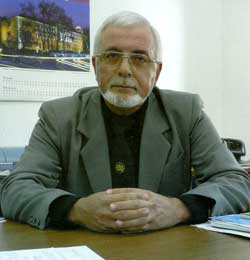 Prof. Ivan Bochev, PhD in Drawing
Prof. Ivan Bochev, PhD in Drawing
1999 – Present – Head of the Department of Drawing and former Dean of the Faculty of Fine Arts, St. Cyril and St. Methodius University of Veliko Tarnovo, Bulgaria
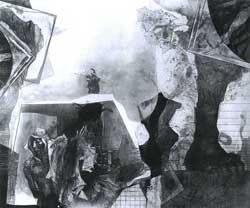 Selected Solo exhibition:
Selected Solo exhibition:
2005 – Sevlievo, Bulgaria;
1998 – Gallery “Spectur, V. Turnovo, Bulgaria;
1996 – Deutsches Theater , Goettingen, Germany;
1996 – Bohemico Gallery Hanover, Germany;
1995 – Town Library, Schwerte, Germay
1994 – National exhibitions in Autumn, Plovdiv, Bulgaria;
1994 – Senator’s Library, Brazil;
1994 – Monica Elizabeth Gallery, Hemer, Germany;
1986 – V. Turnovo, Bulgaria;
1986 – St. Zagora, Bulgaria;
1984 – Varna,
1978 – Cracow, Poland
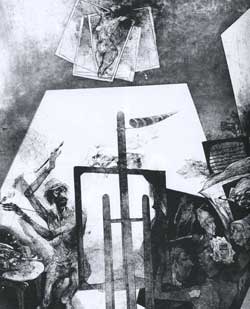 Selected group exhibitions
Selected group exhibitions
2006 – Ankara, Turkey
2006 – Nis, Serbia
2006 – Dimitrovgrag, Serbia
2003 – V. Turnovo, Bulgaria;
2002 – V. Turnovo, Bulgaria;
2002 – Plovdiv, Bulgaria;
2002 – Pleven, Bulgaria;
1997 – International Cultural Center, Cologne, Germany;
1994 – Columbian embassy in Brazil;
1994 – Gallery “Atos Bolkao”, Brazil;
1992 – Gallery “Geizenroy”, Nederlands;
1992 – Gallery Klayne, Vienna, Austria
1992 – London, UK, Oslo, Belgium; Venezuela; Heidelberg, Germany;
1986 – Cracow, Poland;
1895 – Katowice, Poland;
1984 – Moscow, Russia;
1981 – Italy
Some of his works are owned by many galleries and private collectors in Austria, Germany, United Kingdom; Italy, Norway, France, Portugal, Sweden, Japan, USA, Brazil and more.
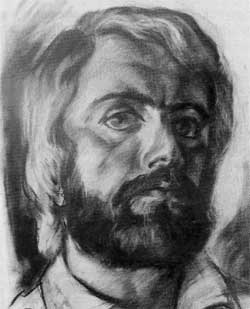 About Prof. Ivan Bochev
About Prof. Ivan Bochev
The majority of our intelligentsia, both in the field of arts and science are closely linked to the ordinary hard working Bulgarian people. They have their roots there; they have lived with their pain, suffering, joys and trepidation.
That explains why they are so sensitive to their people’s historical and social destiny. Professor Ivan Bochev is no exception to this rule. Born in a poor family in the village of Draganovo, Veliko Turnovo district, on 12 October 1946, he grew up in an atmosphere of respect for the ordinary people, their moral principles, their century-old traditions of industry and dedication to life’s creation.
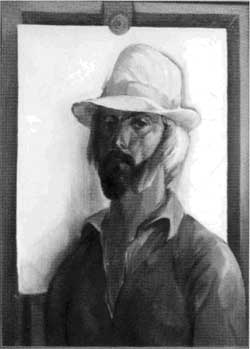 Apart from his personal associations with village life and its working people, the artist-to-be was enthralled by the natural beauty of the Yantra river, meandering through the village of Draganovo, witness to many historical events. In this way, early in his childhood, nature brought him close to history as well. People, nature and history would become the starting points of his art. That helped the child’s sensitive soul to build beauty in its own right, beauty nurtured by the life of his ancestors, the diverse colours and shapes of nature around him. Let us remember that the village of Draganovo is a birthplace of Assen Raztsvetnikov, Kamen Zidarov, Emit Roussaliev and other eminent names from Bulgarian culture. These are writers with a high sense of duty and a genuine feeling for poetry. In his childhood the artist-to-be was enchanted by the poetry of the most lyrical of Bulgarian poets Yavorov, Debelyanov and Liliev. They were the ones who inspired him in his dream of becoming an artist.
Apart from his personal associations with village life and its working people, the artist-to-be was enthralled by the natural beauty of the Yantra river, meandering through the village of Draganovo, witness to many historical events. In this way, early in his childhood, nature brought him close to history as well. People, nature and history would become the starting points of his art. That helped the child’s sensitive soul to build beauty in its own right, beauty nurtured by the life of his ancestors, the diverse colours and shapes of nature around him. Let us remember that the village of Draganovo is a birthplace of Assen Raztsvetnikov, Kamen Zidarov, Emit Roussaliev and other eminent names from Bulgarian culture. These are writers with a high sense of duty and a genuine feeling for poetry. In his childhood the artist-to-be was enchanted by the poetry of the most lyrical of Bulgarian poets Yavorov, Debelyanov and Liliev. They were the ones who inspired him in his dream of becoming an artist.
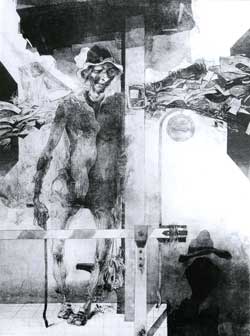 His arrival in Veliko Turnovo to become a student at the High school of Architecture and Construction marks a new stage in his development and growth. Bulgaria’s old capital city instilled a somewhat special attitude in the adolescent Bochev it immersed him not only in the heroic and tragic past of the Bulgarian people it also turned his attention to the national fate, ingraining within him not only a historical viewpoint, but also a philosophical and aesthetic perception of the world. He realizes that the dignity of the individual is inseparable from the dignity of the nation and its concept of harmony and beauty. The high-school where Bochev was a student still remains one of the most prestigious educational institutions in Veliko Turnovo. It boasted some outstanding teachers architects and engineers, literary people, mathematicians, artists and historians.
His arrival in Veliko Turnovo to become a student at the High school of Architecture and Construction marks a new stage in his development and growth. Bulgaria’s old capital city instilled a somewhat special attitude in the adolescent Bochev it immersed him not only in the heroic and tragic past of the Bulgarian people it also turned his attention to the national fate, ingraining within him not only a historical viewpoint, but also a philosophical and aesthetic perception of the world. He realizes that the dignity of the individual is inseparable from the dignity of the nation and its concept of harmony and beauty. The high-school where Bochev was a student still remains one of the most prestigious educational institutions in Veliko Turnovo. It boasted some outstanding teachers architects and engineers, literary people, mathematicians, artists and historians.
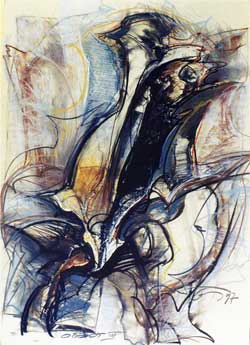 As for the students, they were choice students, creative and inventive. It is not by chance that the majority of them became eminent architects and engineers. There were artists-to-be along with architects and engineers – prof. Bochev, Assoc. prof. Motko Boumov, Assoc. prof. Hr. Tsatsinov, etc. During that period the young Bochev decided to continue his education and pursue his goals in the area of architecture or fine arts. The newly established University of Veliko Turnovo ‘St. Cyril and St. Methodius’ provided an excellent opportunity in that respect with its Arts faculty. And he took advantage of it.
As for the students, they were choice students, creative and inventive. It is not by chance that the majority of them became eminent architects and engineers. There were artists-to-be along with architects and engineers – prof. Bochev, Assoc. prof. Motko Boumov, Assoc. prof. Hr. Tsatsinov, etc. During that period the young Bochev decided to continue his education and pursue his goals in the area of architecture or fine arts. The newly established University of Veliko Turnovo ‘St. Cyril and St. Methodius’ provided an excellent opportunity in that respect with its Arts faculty. And he took advantage of it.
The year was 1971 when Bochev enrolled as a student of fine arts. The study gave the young man a new perspective and status. He became aware of his future as a professional, and began to pursue his goal. Dedicated entirely to his new walk of life, persevering and consistent in his study of art, he soon stood out as one of the highest achieving students. His inspiration came with his own successes and achievements. His attention was drawn to the great masters of the past, and in particular Rembrandt, with the dramatic and psychological nature of his portraits. He was also greatly influenced by the etchings of the genius and his compositions, done using the eau forte technique. Equally he found himself attracted to the works of Michelangelo for his paintings, Leonardo for his perfection and his extensive encyclopedic skills as a scholar and inventor. Obviously this is not unusual, for the artists of today to be inspired by Past Masters. They have always given the generations to come a vision of what can be achieved with skill and creaivity
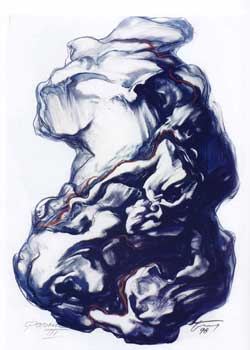 It is also quite logical that the attention of Bochev, the student, should focus on the traditions in Bulgarian art as well on its past and modern achievements. He looked back to the Bulgarian artists, and particularly the Master. He visited his exhibition in the town of Kyustendil with a group of fellow students and it left a lasting imprint on him. At the same time his interest in modern painters – Picasso, Dali etc. intensified.
It is also quite logical that the attention of Bochev, the student, should focus on the traditions in Bulgarian art as well on its past and modern achievements. He looked back to the Bulgarian artists, and particularly the Master. He visited his exhibition in the town of Kyustendil with a group of fellow students and it left a lasting imprint on him. At the same time his interest in modern painters – Picasso, Dali etc. intensified.
As most seeking and talented students, he tried to make out the controversial projections and continuity between the Bulgarian and world art. That helped him discover his idols, learn from them, especially where the precise drawing and interpretation of the shape, colour and composition were concerned. In this respect a good example for him were the outstanding Bulgarian graphic artists Roumen Skorchev, Peter Chuklev and Lyuben Dimanov. The latter brought something new into our graphic art, breaking away from the traditional concepts of composition and gave a new significance to graphic techniques. They impressed him with their etchings in which they achieved an entirely new sound and artistic quality.
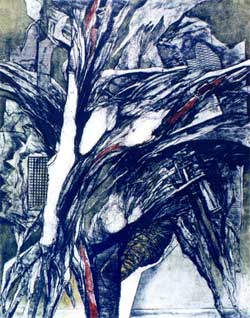 The visits of Bochev, the student, to a number of world museums together with fellow students, boosted his perception of art. The visits to Bucharest, Budapest, Dresden and Leipzig were the first to help him see the great masters of the past. There for the first time he saw Rembrandt’s paintings in the original. He was particularly impressed with the works of Corneliu Baba and Brankuzi. All of them had a direct impact on shaping his exquisite taste and will to master the achievements of world art.
The visits of Bochev, the student, to a number of world museums together with fellow students, boosted his perception of art. The visits to Bucharest, Budapest, Dresden and Leipzig were the first to help him see the great masters of the past. There for the first time he saw Rembrandt’s paintings in the original. He was particularly impressed with the works of Corneliu Baba and Brankuzi. All of them had a direct impact on shaping his exquisite taste and will to master the achievements of world art.
In fact, this is the way most of the representatives of our great art have developed and grown.
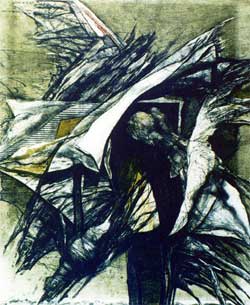 In 1975 Bochev graduated in graphic art at Veliko Turnovo University of ‘St. Cyril and St. Methodius’, Faculty of Fine arts with distinction. Three years later, in 1978 he was invited to teach art, and after winning a competition, he was appointed as a full-time lecturer. In fact this is a logical process which opened up the way for further professional growth. The young artist found himself in a new environment which pushed him forwards and upwards. Bochev’s colleagues know that his artistic contributions began as early as 1975, when he was a student. It is well known how much excitement and tension events like these involve. They do become real events, a memory sweet and dear to the heart. The young artist had the opportunity to participate in two national exhibitions with two figure compositions relating to history. This time of keen interest in national history, resonates with Bochev. For the young artist who has grown up in the atmosphere of the historical Turaovgrad this is a natural response. At this same period of the 1970s he embarked on portrait and figure compositions, with which he participated in a few general art exhibitions.
In 1975 Bochev graduated in graphic art at Veliko Turnovo University of ‘St. Cyril and St. Methodius’, Faculty of Fine arts with distinction. Three years later, in 1978 he was invited to teach art, and after winning a competition, he was appointed as a full-time lecturer. In fact this is a logical process which opened up the way for further professional growth. The young artist found himself in a new environment which pushed him forwards and upwards. Bochev’s colleagues know that his artistic contributions began as early as 1975, when he was a student. It is well known how much excitement and tension events like these involve. They do become real events, a memory sweet and dear to the heart. The young artist had the opportunity to participate in two national exhibitions with two figure compositions relating to history. This time of keen interest in national history, resonates with Bochev. For the young artist who has grown up in the atmosphere of the historical Turaovgrad this is a natural response. At this same period of the 1970s he embarked on portrait and figure compositions, with which he participated in a few general art exhibitions.
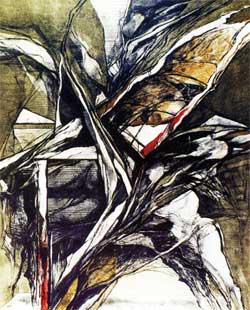 His first exhibition took place in 1978 in the city of Krakow, Veliko Tumovo’s twin city. It featured 25 etchings and drawings. This first exhibition proved crucial in his development and gave his works a new direction. The exchange of experience with Poland’s leading graphic artists in terms of mentality, means of expression and techniques led him back to graphic art. It is well known that the pursuit of innovation is one of the distinctive features of Polish art.
His first exhibition took place in 1978 in the city of Krakow, Veliko Tumovo’s twin city. It featured 25 etchings and drawings. This first exhibition proved crucial in his development and gave his works a new direction. The exchange of experience with Poland’s leading graphic artists in terms of mentality, means of expression and techniques led him back to graphic art. It is well known that the pursuit of innovation is one of the distinctive features of Polish art.
Establishing contacts within the Polish artistic circles revealed to him the modern means of expression in graphic art. In this respect the Varna biennale in 1981 was a major incentive for him. It became a breeding ground for Bulgarian graphic artists. A number of Bochev’s fellow students also participated in it, graduates of Veliko Turnovo university GeorgiLechev, TodorTachev, Nikolai Nikolov, etc. In the first biennale of graphic art in Varna, Bochev presented three graphic pieces, the one which stands out is called ‘A Hug1. The artist himself considers it a program piece, done during his trip to Poland and the exhibition which he did there. In it, as well in his other pieces, he demonstrated his attitude to graphic composition and its aesthetic values. He displays a skill at what he’s doing, creating a near perfect balance between visual impression, innovation and graphic expression something that establishes him as an artist with his own style and a position in art.
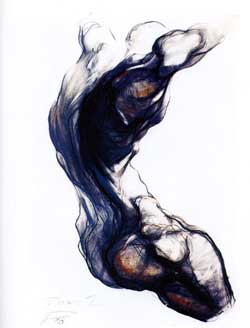 To be a good teacher at a higher educational institution of arts, you must be a renowned creator. These requirements are inseparable. This is what is specific to the teachers they do not teach students about titles (though it is obligatory), they teach artistic skills. The creative example here is the leading one you should not only know it but you also be able to do it! The department which the young artist joins contributes to that a lot as well (in the beginning “Painting1, then ‘Drawing’, headed by prof. Spiridon Borisov). To this must be added ‘Young artist’s studio’ with the Union of Bulgarian artists whose member Bochev is at the time. Accommodated in the famous ‘Sparrow’s house’, its members, the sculptors Margarita Pueva and Angel Angelov, the artist St. Petkov generate a genuinely creative atmosphere. Obviously, they could not distance themselves from the hopes and disappointments of their generation which became an integral part of their life. fate. It is they that bring them closer to the national and wider spiritual and aesthetic trends of the European art. Bochev himself defines this period – the 1980s as the ‘most fruitful1 in his life. This is the time when he participates in many exhibitions at home and abroad, organized by the ‘Graphic art’ section of the Union of Bulgarian artists. We will mention only some of them: 1981 Italy, 1984 Moscow, 1985 Katowice, Poland, 1986 Krakow, Poland. At the same time he does a series of exhibitions of his own: 1978 Krakow, 1984 Varna; 1986 V. Turnovo. We should also mention his frequent participation in general arts exhibitions. In the early 1970s and early 1980s Bochev’s art is naturally dominated by graphics. We will mention some of his most significant works and cycles. These are the graphic cycle, consisting of three graphic pieces ‘Profiles’, ‘Solstice’, ‘Reincarnation’ , inspired by Bulgakov’s novel ‘The Master and Margarita’. In it the artist raises one of the most inherent problems of art about the relationship between imagination and sleep, between the magical and reality. We see a pursuit of introspection, and a more philosophical view of things in life. The associative and methaphorical approach, the abstract expressiveness are helped by the deep sensitivity, the commensurate perfectionism in the technique and a feeling of aesthetic proportion. Other graphic pieces from this period are’ Last stop’, ‘Alternative’, Abduction’, ‘Barrier’, ‘ Circulation’, a set of graphic drawings based on Yordan Yovkov’s works, etc. in all of them we see Bochev as a creator who is able not only to formulate and raise the problem but also to tackle it in a supple and convincing manner. The author impresses us with his ability to saturate art space with figurative elements by which he achieves certain symbolic suggestions and associative thought. In this way he gives a meaning to the issue of the link between the concrete image and the distancing from it, an issue so important to graphic art. The use of a wide range of graphic techniques gives the author greater creative freedom and diversity in the artistic expression. In the development of his style, Bochev follows not only the course and requirements of time but also the inner logic in the evolution of his talent, revealing its new aspects.
To be a good teacher at a higher educational institution of arts, you must be a renowned creator. These requirements are inseparable. This is what is specific to the teachers they do not teach students about titles (though it is obligatory), they teach artistic skills. The creative example here is the leading one you should not only know it but you also be able to do it! The department which the young artist joins contributes to that a lot as well (in the beginning “Painting1, then ‘Drawing’, headed by prof. Spiridon Borisov). To this must be added ‘Young artist’s studio’ with the Union of Bulgarian artists whose member Bochev is at the time. Accommodated in the famous ‘Sparrow’s house’, its members, the sculptors Margarita Pueva and Angel Angelov, the artist St. Petkov generate a genuinely creative atmosphere. Obviously, they could not distance themselves from the hopes and disappointments of their generation which became an integral part of their life. fate. It is they that bring them closer to the national and wider spiritual and aesthetic trends of the European art. Bochev himself defines this period – the 1980s as the ‘most fruitful1 in his life. This is the time when he participates in many exhibitions at home and abroad, organized by the ‘Graphic art’ section of the Union of Bulgarian artists. We will mention only some of them: 1981 Italy, 1984 Moscow, 1985 Katowice, Poland, 1986 Krakow, Poland. At the same time he does a series of exhibitions of his own: 1978 Krakow, 1984 Varna; 1986 V. Turnovo. We should also mention his frequent participation in general arts exhibitions. In the early 1970s and early 1980s Bochev’s art is naturally dominated by graphics. We will mention some of his most significant works and cycles. These are the graphic cycle, consisting of three graphic pieces ‘Profiles’, ‘Solstice’, ‘Reincarnation’ , inspired by Bulgakov’s novel ‘The Master and Margarita’. In it the artist raises one of the most inherent problems of art about the relationship between imagination and sleep, between the magical and reality. We see a pursuit of introspection, and a more philosophical view of things in life. The associative and methaphorical approach, the abstract expressiveness are helped by the deep sensitivity, the commensurate perfectionism in the technique and a feeling of aesthetic proportion. Other graphic pieces from this period are’ Last stop’, ‘Alternative’, Abduction’, ‘Barrier’, ‘ Circulation’, a set of graphic drawings based on Yordan Yovkov’s works, etc. in all of them we see Bochev as a creator who is able not only to formulate and raise the problem but also to tackle it in a supple and convincing manner. The author impresses us with his ability to saturate art space with figurative elements by which he achieves certain symbolic suggestions and associative thought. In this way he gives a meaning to the issue of the link between the concrete image and the distancing from it, an issue so important to graphic art. The use of a wide range of graphic techniques gives the author greater creative freedom and diversity in the artistic expression. In the development of his style, Bochev follows not only the course and requirements of time but also the inner logic in the evolution of his talent, revealing its new aspects.
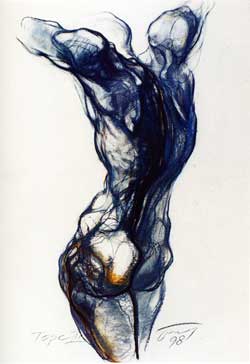 After the mid 1980s the artist began to spend more time and attention to the drawing. The reason for that as he himself sees it is his work as a teacher of painting/drawing at the Arts Faculty of Veliko Turnovo university. The drawing which is a ‘starting point’ for many, the onset of every composition or a painting means to Bochev a complete and an accomplished work of art. He looks upon it as a means of expressing certain intentions; it is also a way of full creative expression. To him the drawing, as a separate piece, is not limited only to solving problems, it acquires certain spiritual content and charge. What is more, through it the artist sets himself the ambitious task of expressing his aesthetic positions and ideas. So Bochev’s drawings, following the organic development of his works, express to the highest degree his position as an artist, vitality and artistic nature.
After the mid 1980s the artist began to spend more time and attention to the drawing. The reason for that as he himself sees it is his work as a teacher of painting/drawing at the Arts Faculty of Veliko Turnovo university. The drawing which is a ‘starting point’ for many, the onset of every composition or a painting means to Bochev a complete and an accomplished work of art. He looks upon it as a means of expressing certain intentions; it is also a way of full creative expression. To him the drawing, as a separate piece, is not limited only to solving problems, it acquires certain spiritual content and charge. What is more, through it the artist sets himself the ambitious task of expressing his aesthetic positions and ideas. So Bochev’s drawings, following the organic development of his works, express to the highest degree his position as an artist, vitality and artistic nature.
The political changes ruined the organized life at the Union of Bulgarian Artists for a long time, something which affected their artistic output. However, the possibility of trips and events abroad grew considerably. In the 1990s Bochev had a few exhibitions in Brazil /the Senate’s libriray, ‘Atos Bolcao’ gallery, Colombian embassy/ and Germany /Hemmer, Schwerte, Hannover, Goetengen/, at home Plovdiv, Stara Zagora, V. Turnovo, as well as collective exhibitions in Cologne, Vienna, London, Oslo, etc. therefore, the artist’s work did not decline, on the contrary, it expanded to a number of countries in Europe and Latin America.
In 1991 Bochev, quite naturally, became an associate professor. In his research the author tries to ‘study and keep the dynamic energy of the drawing’, and to find ‘that elusive transition between a study drawing composition’. His works that made him an associate professor are ‘Sitting woman’, ‘Back of a sitting man’ and ‘Sitting woman’. These works, done in the classic drawing material – charcoal, have the expressiveness of the original creative impulse and are intended to defend certain aesthetic positions and ideas. The familiar nude body, has been interpreted through original decisions and a convincing ease of the expression. The real tangible shape brings a strong inner charge, keeps the freshness of the initial creative spontaneity, and impresses with artistic and original character. Bochev adds to his works as an associate professor a number of drawings ,among them ‘ Nude body I’, ‘Nude body II’, ‘ Lady’s portrait’, ‘Polyptich’, etc., done in pastel and sepia. These drawings, too, are characterized by spontaneity, naturalness and professional standard. The varied, now soft and flexible, now sharp and clear line has been enriched by the delicate presence of colour. All this renders the drawings vital and natural, which are common only to real talent. Apart from the works already mentioned, he adds eight graphic works, among them ‘Circulation1, ‘Abduction1, ‘Barrier1. Undoubtedly, this stage of Bochev’s works is marked by convincing artistic achievements. It gives his development a new direction. When in 2000 he applied for a professor, his attention was drawn to colour in a drawing. In the competition for a professor, Bochev participates with a considerable number of drawings, etchings, done professionally. The works are: ‘Torso I, II, III’, ‘Figure I, II, III, done in black and colour crayon; ‘Object’ II, V, VI1, ‘Structure and Toilet1 done with crayon and colour pastel. In the drawings of the Torso I III’and’ Figure I III’ cycle, the artist presents a new understanding of the artistic image. He does not provide alternatives to easy perception we already know, he puts it on an entirely new-quality level. The new set of images and type of interpretation are very convincing, as an emotional suggestion and psychological presence. Of course, this image of the artist is both new and expected because it is predetermined by his way, by his creative and stylistic evolution.
Although Bochev’s drawings have been inspired by the visible human figure, they go out of the visible transcend the outer description which is why they fill the image with philosophical content and sound. Thus he answers the questions which every artist asks himself/herself about the mystery of life, about creation and destruction, about good and evil, beautiful and ugly, etc.
Very harmonious and dense as a structure and an emotional charge, these figures express his search for style and preferences in the direction of free and artistic improvisation. The outline of volumes, the expressive deformation, the dynamic shapes, speak of inner tension which breaks out in the colour, present both as a line and as a spot. The palette which the artist normally uses is muffled though in some places strong and unexpected highlights literally blow up the space of the drawing, intensifying the feeling of the work which reaches dramatic proportions sometimes. To his works as an associate professor Bochev adds 5 extra drawings – ‘Form I V and graphic drawings ‘ Scene11 V, Journey I and II.
‘Form I V are particularly impressive, inspired by natural rock shapes. One can feel the basic element of creation in them. The role of the artist here is the role of creator. Possessing strong inner passion, and exciting intensity, bordering on expression at places, these works indicate personal trepidation and passion, personal positions and spiritual space. At the same time they abound in fresh enchantment and a desire to keep the spontaneity of the first creative impulses. The ‘Torso I III’ and ‘Form I V( series perhaps firmly position the drawing in Bochev’s works and prove his skill to raise it to a degree where it can be looked upon as a drawing-picture. The three cycles – ‘Drawings’, ‘Object’, and ‘ Structure’ aim to solve some problems related to flexibility and space, structure and composition, by using the means of the drawing. By making the shape dynamic, the ‘Torso’ I, II, III and ‘Figure’ I, II, III cycle emotionally saturates the image. To achieve that, the author uses an expressive line, black-and-white spots, and colour spots. The emphasis is on the active supple movements, the anatomical characteristics being dominated by the overall effect.
Along with that, the effects of the light for emphasizing the movement, form and condition have been used. The conventional colour has been organically interwoven in the structure of the composition with the aim of enriching and clarifying the architecture of space, etc. Without expanding in detail on the other cycles, I will say that Professor Bochev has achieved an incredible success in studying the emotional impact which the universal language of the drawing possesses. With him the creative impulse goes hand in hand with the rational expressiveness, the intense interpretation of human nature. His sensitivity carries in itself the present-day emotions of the civilized man. This can be seen in the dynamic energy of the drawing and the elusive transition study drawing composition. The works with which Bochev applies as a professor are indicative ofhis enormous artistic achievements.
The picture will not be complete if we do not mention that many galleries and private collections at home and abroad own his works: the National Arts Gallery, Sofia City Gallery, Graphic Studio in Varna, the Art galleries in Veliko Turnovo, St. Zagora, Montana, Dobrich, Shoumen, Varna, Bourgas, etc. his works can be found in a number of private collections in Austria, Germany, UK, Italy, Norway, France, Portugal, Sweden, Japan, USA, Brazil, etc. This is a major achievement for a Bulgarian artist. It speaks of his huge artistic capacity, and his name and place in Bulgarian art and in the world. It is not by chance that a number of positive reviews and articles have been published about professor Bochev in magazines such as ‘Art’, ‘Problems of Art’, and ‘The Culture1 weekly, that is the most reputable Bulgarian art media. To these should be added professor Bochev’s works, published in some editions of The Union of Bulgarian Artists. They are related mostly to participation of the ‘Graphic art’ section at biennales in graphic art, and to the general art exhibitions where he participates.
Professor Bochev’s academic work goes together with his work as an artist. Combining both is once again proof of his great success as a talented teacher and educator. He can captivate his students and instill confidence in them and their creative abilities. Many are the students who have spoken highly about their teacher and his help and guidance in their search for creative values. Professor Bochev has had administrative commitments for many years. Since 1990 he has been chairman of the Artists’ Association in Veliko Turnovo, head of ‘Drawing’ department and deputy dean. He has been a Dean since 1999
Professor Bochev’s academic work goes together with his work as an artist. Combining both is once again proof of his great success as a talented teacher and educator. He can captivate his students and instill confidence in them and their creative abilities. Many are the students who have spoken highly about their teacher and his help and guidance in their search for creative values. Professor Bochev has had administrative commitments for many years. Since 1990 he has been chairman of the Artists’ Association in Veliko Turnovo, head of ‘Drawing’ department and deputy dean. He has been a Dean since 1999.
As a Deputy Dean of the Faculty of Arts at Veliko Turnovo University Professor Bochev has dedicated a lot of time and effort to boost its reputation. Thanks to these efforts, new specialities were created, new departments were set up, the age of associate professors and lecturers is relatively young, the admission and training of students is improving, the students’ involvement in the events of the faculty is impressive. Last but not least are the facilities, equipment, etc., which have increased considerably.
Definitely talented and exacting to himself, professor Bochev is one of our eminent graphic artists who represent in the most successful way the achievements of the Arts Faculty in Bulgarian art. As its long-standing dean, he has contributed immensely to the development and growth of many talented artists and teachers for the Bulgarian schools and arts faculties across the country. An artist of established views, clear plastic principles, deep thinking and sensitivity, I. Bochev proves in the most convincing way his presence in modern Bulgarian art. He sees his 60-th birthday with the dignity of a man who has fulfilled his duty as an artist and teacher.
Antoaneta Ancheva, Assoc. prof. PhD
Ivan Bochev Monograph Album, Published by St. Cyril and St. Methodius University of Veliko Tarnovo, Bulgaria


Write a comment: